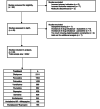Development of the treatment prediction model in the artificial intelligence in depression - medication enhancement study
- PMID: 40550942
- PMCID: PMC12185704
- DOI: 10.1038/s44184-025-00136-8
Development of the treatment prediction model in the artificial intelligence in depression - medication enhancement study
Abstract
We introduce an artificial intelligence model to personalize treatment in major depression, which was deployed in the Artificial Intelligence in Depression: Medication Enhancement Study. We predict probabilities of remission across multiple pharmacological treatments, validate model predictions, and examine them for biases. Data from 9042 adults with moderate to severe major depression from antidepressant clinical trials were used to train a deep learning model. On the held-out test-set, the model demonstrated an AUC of 0.65, outperformed a null model (p = 0.01). The model increased population remission rate in hypothetical and actual improvement testing. While the model identified escitalopram as generally outperforming other drugs (consistent with the input data), there was otherwise significant variation in drug rankings. The model did not amplify potentially harmful biases. We demonstrate the first model capable of predicting outcomes for 10 treatments, intended to be used at or near the start of treatment to personalize treatment selection.
© 2025. The Author(s).
Conflict of interest statement
Competing interests: D.B., C.A., K.P., R.F., J.M., S.I. were employees and/or shareholders of Aifred Health and supported this research in the context of their work for Aifred Health. DB receives a salary award from the Fonds de recherche du Québec – Santé (FRQS). A.K., S.P. have previously received an honorarium from Aifred Health. J.F.K. has been provided options in Aifred Health. K.H. and G.T. do not report any competing interests. All authors have read and approved the manuscript.
Figures





References
-
- Health Organization, W. Depression and other common mental disorders: global health estimates. (2017).
-
- Rush, A. J. et al. Acute and longer-term outcomes in depressed outpatients requiring one or several treatment steps: a STAR*D report. Am. J. Psychiatry163, 1905–1917 (2006). - PubMed
-
- Benrimoh, D. et al. Aifred Health, a Deep Learning Powered Clinical Decision Support System for Mental Health. in The NIPS ’17 Competition: Building Intelligent Systems 251–287 (Springer International Publishing, 2018).
LinkOut - more resources
Full Text Sources

